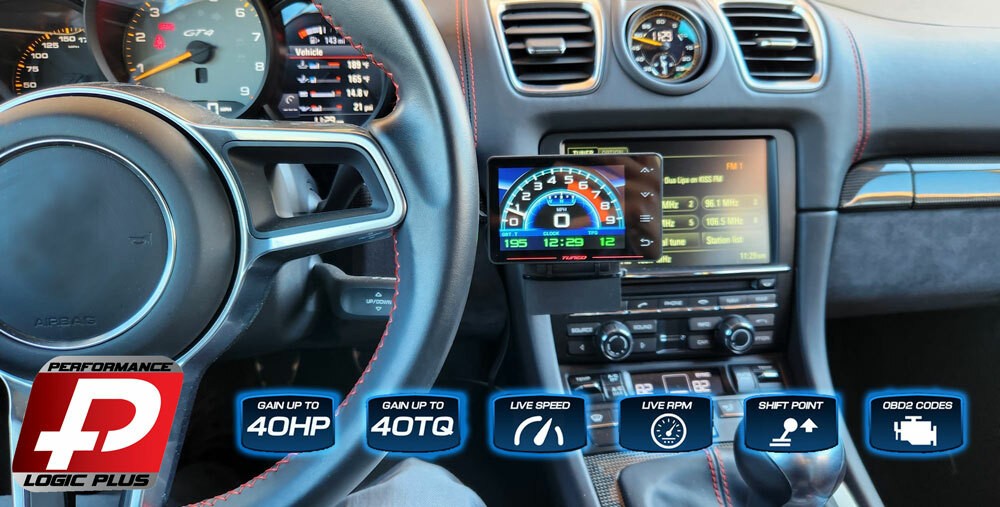Are you looking to boost your Toyota’s performance without complex modifications? The Stage 4 Performance Chip Module OBD2 promises to enhance your vehicle’s horsepower and torque, while also providing a range of digital monitoring features. In this review, we’ll delve into the specifics of this performance module, exploring its capabilities, ease of use, and whether it lives up to the hype for Toyota owners seeking a performance edge.
What is a Stage 4 Performance Chip Module OBD2?
A Stage 4 performance chip module, like the Performance Logic Plus+ (PLP+), is designed to plug directly into your vehicle’s OBD2 port – typically located under the dashboard. This connection allows the module to communicate with your car’s engine control unit (ECU) and subtly optimize performance parameters. The Stage 4 designation often implies a focus on power gains, and in this case, it also integrates advanced technology like a digital display and OBD2 diagnostic functions, setting it apart from simpler performance enhancers. These modules are marketed as a straightforward way to increase horsepower and torque without requiring mechanical modifications or ECU retuning for basic bolt-on parts.
Key Features and Benefits of the Stage 4 PLP+
This Stage 4 performance chip module boasts an array of features aimed at improving your Toyota’s driving experience and providing valuable vehicle data:
- Performance Enhancement: Claims up to 40 horsepower and 40 lb-ft of torque increase, custom-tuned for your specific Toyota model and engine type.
- Real-time Data Display: Features a built-in display to show live speed, RPM, coolant temperature, battery voltage, and more. This allows for immediate monitoring of your vehicle’s vital signs.
- Adjustable RPM Shift Point Warning: Helps optimize shifting for manual transmissions and provides performance feedback for automatics.
- Performance Testing: Includes tools to measure 0-60 mph times and braking performance, allowing you to quantify improvements.
- Fuel Consumption Data: Provides insights into fuel efficiency, although performance enhancements may affect this.
- OBD2 Diagnostic Capabilities: Reads and clears check engine codes, potentially saving you trips to a mechanic for minor issues.
- G-Force and Slope Angle Meter: Adds fun and potentially useful data points, especially for enthusiasts or off-road drivers.
- Simple Plug-and-Play Installation: Designed for easy installation by simply plugging into the OBD2 port, with no need for special tools or automotive expertise.
 Performance Chip Tune LCD Horsepower and Torque
Performance Chip Tune LCD Horsepower and Torque
Image of the Stage 4 performance chip module LCD screen displaying horsepower and torque data.
Easy Installation and Compatibility
One of the primary selling points of OBD2 performance chips is their ease of installation. The Stage 4 module is designed for a simple plug-and-play setup. You locate your Toyota’s OBD2 port, typically found beneath the driver’s side dashboard, and connect the module. The device is advertised to automatically turn on and enter standby mode when the vehicle is off, minimizing battery drain. It is marketed as compatible with a wide range of Toyota engines, including:
- Regular Gas Engines
- Turbocharged Engines
- Supercharged Engines
- Hybrid Engines
- Turbo-diesel and Diesel Engines
- Automatic and Manual Transmissions
This broad compatibility aims to make the Stage 4 module a versatile option for many Toyota owners from 2005 onwards.
Addressing Common Concerns: Warranty and Safety
Concerns about warranty invalidation and vehicle safety are common when considering aftermarket performance modifications. The manufacturer addresses these directly:
- Warranty: They state that the module will not void your Toyota’s warranty, citing the Magnuson Moss Warranty Act in the US. They recommend removing the module before dealership servicing to avoid potential concerns, although legally, aftermarket parts shouldn’t automatically void a warranty.
- Engine and Electronics Safety: The product is claimed to be safe for your engine and vehicle electronics, with assurances of DYNO testing to confirm safe operation. Crucially, they state that original engine safety and emission features remain intact.
- Strain on Engine and Transmission: They reassure users that the module will not place undue strain on the engine or transmission, maintaining the dependability of your Toyota.
Stage Comparison
To illustrate the positioning of the Stage 4 module, here’s a comparison with other stages mentioned in the original article:
| HORSEPOWER | TORQUE | GAS SAVING | |
|---|---|---|---|
| STAGE 1 (FUEL SAVER CHIP) | +16.2 ft·lbs | ✓ | |
| STAGE 2 (ALL-AROUND CHIP) | +24.2 ft·lbs | ✓ | |
| STAGE 3 (FOCUSED IN POWER) | +32.3 ft·lbs | N/A | |
| STAGE 4 (FOCUSED IN POWER + TECHNOLOGY) | +40 HP / +32.3 ft·lbs | +40 TQ / N/A |
Note: Results can vary. The table has been updated to reflect the 40HP/40TQ claim mentioned earlier in the rewritten article while retaining the original table structure and values where applicable.
This table suggests that Stage 4 is positioned as the top-tier option, focusing on both power and technological features, while earlier stages might prioritize fuel efficiency or a balance of performance and economy.
Conclusion
The Stage 4 Performance Chip Module OBD2 offers Toyota owners a compelling package of performance enhancement and vehicle monitoring features. With its promise of increased horsepower and torque, coupled with real-time data display and OBD2 diagnostics, it aims to provide a comprehensive upgrade experience. The plug-and-play installation and assurances regarding warranty and safety make it an attractive option for those seeking accessible performance gains without extensive modifications. For Toyota enthusiasts looking to explore their vehicle’s hidden potential, the Stage 4 performance chip module is worth considering.